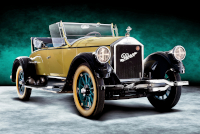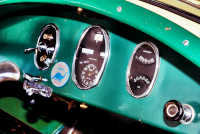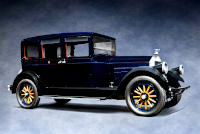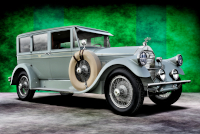Location:
RM Sotheby's, Hershey, 2023
Owner: Conrad Fletcher | Golden, Colorado
Prologue:
A parade of portraits... Of the Colorado Pierce-Arrow cars at RM Hershey, I profiled three, and of those I actually looked forward to this Model 80 Runabout most. Ornamental details in RM's gallery piqued my curiosity—the castings, colors, pinstripes, and patina. Working close, portraits make ready vignettes of these details, and here I found quite a few.
The car itself is probably not the last Model 80 Runabout we'll see, a popular configuration on a series aimed at broadening Pierce-Arrow's customer base. From the standpoint of old cars, this one is a nice example. Like its companions on offer that lovely October afternoon, chassis #8011609 feels genuine and of-the-period. Truly classic, (not concours), which is a quality I feel this catalogue needs.
- - - - - - - - - -
► Image Source: Nikon D750 (24.3 MP)
References:
- Ralston, Marc. "Pierce-Arrow" A.S. Barnes & Co., Inc., San Diego, CA. 1980, page 119-120, 232
- Automobile Quarterly, Volume 28, Number 4, Fourth Quarter 1990, "Change and Prosperity" by John C. Meyer III, The Kutztown Publishing Company, Inc., Kutztown, PA, page 73-74
- Automobile Quarterly, Volume 6, Number 3, Third Quarter 1968, "Pierce-Arrow: An American Aristocrat" by Maurice D. Hendry, The Kutztown Publishing Company, Inc., Kutztown, PA, page 257
- RM Sotheby's: The Hershey 2023 auction listing for #8011609.
- Chicago Vintage Motor Carriage: A nice article on their beautiful 1927 Model 80 Rumabout, with good references to manufacturing quality.
A public favorite, Pierce-Arrow shake off the harness of stodgy luxury automobiles with a car people are waiting for. The Model 80 Runabout is a lighter, simpler, cheaper Pierce-Arrow with free-spirited open coachwork built to the company's exacting standards. By the looks, the Model 80 is not much different than many cars of the antique period, but that similarity puts the new series on-trend. Though one still requires some surplus cash to indulge, the Model 80 lowers the Pierce-Arrow pricepoint. In turn, sales experience a modest boom. Finally, customers can own a handsome car with the now-famous integrated headlamps at a substantial discount from the top-end Model 33.
In turn, Model 80 Runabouts abound, particularly today when old open cars draw more attention than their utilitarian cousins (sedans). The runabout is a 2/4 place style with a rumble seat behind the passenger compartment. This example also features a golf club compartment on the flank, just near the rear step, a nod to the runabout's recreational aspirations.
As with a full-fledged Pierce-Arrow, Model 80 light six mechanicals received fanatical attention, including the same balancing, honing, testing, and assembly-disassembly processes that made the big sixes so durable. In this respect, there is considerable substance behind those patented headlamps, as Pierce-Arrow did not simply brand a down-market car to capitalize on its reputation. The Model 80 is rather economized in its scale and straightforward production, allowing the factory to produce more units and meet consumer demand. And so, for the roaring twenties, the Model 80 Runabout is in the spirit. Only that Pierce-Arrow will use this success as a means to claw back into the luxury market with old, stodgy ideals (the Model 36) does the intelligence of the series come to an end. The Model 80 lives in this decade, and Pierce-Arrow will not continue its likes or see fit to replicate such a popular approach.
Motor: 4,727.7 cc (288.5 cubic inches) "light six" inline 6-cylinder | 88.9 mm x 127 mm (3½" x 5")
Though smaller and simpler than the 4-valve six in the Model 33, this single cast "en bloc" unit retained the same fanatical attention to the balance and honing of its components, and still used composite alloys for the crankcase and camshaft.
Valvetrain: L-head, 2 valves per cylinder
Aspiration: single carburetor
Power: 70 hp @ 2,800 rpm
Taxable 38 hp rating
Drivetrain: 3-speed manual transmission, rear-wheel drive
Pierce-Arrow retired the 4-speed manual in 1919 with the Model 31. The loss of the top-most gear therefore limits top speed.
Front Suspension: semi-elliptic leaf springs with Houdaille shock absorbers, new for the Model 80
Rear Suspension: live axle with three-quarter-elliptic leaf spings and Houdaille shock absorbers
Architecture: steel frame, aluminum panels on northern white ash
Wheelbase: 3,302 mm (130 inches)
Etymology:
The Model 80 is its own project, perhaps the first Pierce-Arrow that is neither successor nor derivation of the original Pierce automobile plan. In turn, its numerical designation is singular, if not completely random. There is no precedent for '80' and no major corresponding technical specification. My best guess is that, by 1924, Pierce had already faced years of pressure from the automotive industry to adopt an 8-cylinder drivetrain, but were never willing to capitulate. While a new model aimed at a middle-market segment would not be the platform to introduce an eight, the Model 80 would eventually serve as the basis for the first Pierce-Arrow 8-cylinder. This form of motor development, up-rating a 6-cylinder to an 8-cylinder, is wholly conventional, and yet had not been Pierce-Arrow's modus operandi since their move to six cylinders in 1907. So perhaps what we see in the Model 80 is an aspiration to meet popular demand, if not for the Pierce philosophy, then for survival. It's as though Pierce-Arrow said, "We want a popular car, and '8' is a popular number. We'll go with that."
I use the 'runabout' name instead of 'roadster,' as the former keeps consistent with Pierce-Arrow styles dating back to the teens, and because 'roadster' intimates more sporting aspirations than the company ever mustered.
Figures:
Marc Ralston notes that no records confirm the exact number of Model 80 cars built, estimating 7,500 units in 1926. Of these, the runabout is a popular configuration.
Value:
Chassis #8011609 sold for $34,100 at RM Sotheby's Hershey auction in 2023. Price when new was $2,895.
Cast Detail: Cast Ornament on the Antique Pierce-Arrow
Most interesting is the cast cameos on the front and rear guards. This design is the same as used on Pierce-Arrow coachwork badges, also seen on the Model 36 Winterfront radiator shroud; it is a quarter perspective featuring the integrated Herbert Dawley headlamps. The pattern is best seen in the portrait. The guard is an interesting bow design with an open plat between the rails, behind which we see a larger cast Pierce shield. This intricate guard does not appear to be common at all, as most period Pierce-Arrow cars of this vintage use a simple bar.
Wheel Mascot: The Nickel Era Wheel and Arrow that Precedes the Archer
Prior to the archer (tireur d'arc), Pierce-Arrow sometimes used a wheel and arrow motif, which in itself is somewhat funny as it seems to glorify the ever-so inconvenient punctured tyre. These designs stem from the teens, with our catalogue showing a simpler version on the 1917 Model 48-B-4. By 1926, the motif shifts forward by about 45 degrees on an ornamental pedestal with fluid lines and subtle curls. The arrow remains large and playful, a wholly different impression than that of the archer's visceral athleticism.
Color and Patination: Discussing Livery and Condition
The pale custard body and teal trim look appropriate for the period. Best is the orange arrow pinstripe on the teal binding, which begins with the arrowhead at the grille and ends with a tail feather flourish by the rumble seat. This pinstripe is another playful detail that matches the runabout's spritely character. The teal complement continues on the wooden artillery wheels, which, though wholly appropriate for this type of automobile, Pierce-Arrow rather preferred to wires. The seats use tufted teal hides, and the covers for the top and the spare use matching teal hem lines.
Closer looks show the paint cracks and missing patches, but chassis #8011609 provides a lot of clever little details and enough playful kitsch to make the wear feel well earned. The effect is true American old car. To this point, on the dashboard we see a Sinclair petrol dinosaur badge, and on the radiator front a Denver Motor Club badge, (which I believe reads, "Gold State Automobile Association"). The latter probably joined the car under Mr. Fletcher's ownership, much as he termed his cars The Grand Canyon Collection.
Last Updated: Mar 26, 2025













